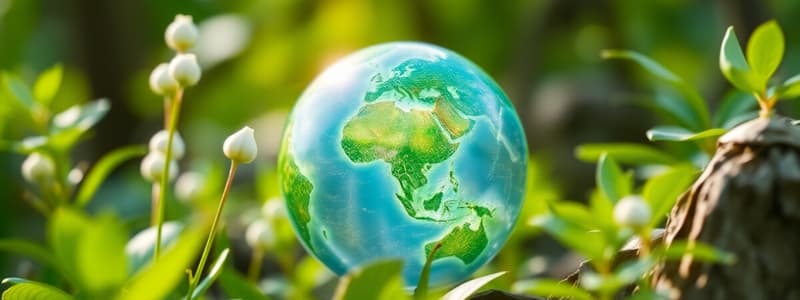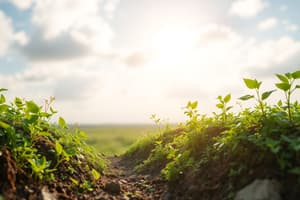Podcast
Questions and Answers
What is the primary focus of ecology?
What is the primary focus of ecology?
- The interaction of living organisms with each other and their environment (correct)
- The study of physical Earth processes
- The classification of species
- The exploration of planetary systems
Which of the following is NOT a component of the biosphere?
Which of the following is NOT a component of the biosphere?
- Ecosystem Dynamics (correct)
- Lithosphere
- Atmosphere
- Hydrosphere
What defines sustainability in an ecological context?
What defines sustainability in an ecological context?
- The management of natural resources for short-term benefits
- The maintenance of human dominance over nature
- The ability of populations to interact and reproduce indefinitely (correct)
- The capability of populations to thrive in a diverse environment
Which process breaks down glucose to produce energy and releases carbon dioxide?
Which process breaks down glucose to produce energy and releases carbon dioxide?
Which of the following accurately describes limiting factors?
Which of the following accurately describes limiting factors?
What occurs when the birth and death rates of a population are balanced?
What occurs when the birth and death rates of a population are balanced?
What is the role of decomposers in nutrient cycling?
What is the role of decomposers in nutrient cycling?
What is the carrying capacity of an environment?
What is the carrying capacity of an environment?
What is the primary role of producers in an ecosystem?
What is the primary role of producers in an ecosystem?
In which type of symbiotic relationship do both species benefit?
In which type of symbiotic relationship do both species benefit?
What process describes the conversion of nitrogen into usable forms by bacteria?
What process describes the conversion of nitrogen into usable forms by bacteria?
What percentage of energy is typically transferred from one trophic level to the next in an energy pyramid?
What percentage of energy is typically transferred from one trophic level to the next in an energy pyramid?
Which of the following best defines the term 'niche' in an ecosystem?
Which of the following best defines the term 'niche' in an ecosystem?
Which cycle involves the process of evaporation and precipitation?
Which cycle involves the process of evaporation and precipitation?
What is the impact of monoculture on biodiversity?
What is the impact of monoculture on biodiversity?
What does the term 'biomagnification' refer to?
What does the term 'biomagnification' refer to?
Which of the following is a primary consumer in a food chain?
Which of the following is a primary consumer in a food chain?
What effect do pesticides generally have on ecosystems?
What effect do pesticides generally have on ecosystems?
Flashcards
Ecology
Ecology
The study of how living organisms interact with each other and their environment.
Environment
Environment
All living and non-living things on Earth and their interactions.
Sustainability
Sustainability
The ability of populations to survive and reproduce indefinitely.
Stewardship
Stewardship
Signup and view all the flashcards
Photosynthesis
Photosynthesis
Signup and view all the flashcards
Cellular Respiration
Cellular Respiration
Signup and view all the flashcards
Carrying Capacity
Carrying Capacity
Signup and view all the flashcards
Biodiversity
Biodiversity
Signup and view all the flashcards
Community
Community
Signup and view all the flashcards
Niche
Niche
Signup and view all the flashcards
Energy Flow
Energy Flow
Signup and view all the flashcards
Food Chain
Food Chain
Signup and view all the flashcards
Food Web
Food Web
Signup and view all the flashcards
Autotrophs
Autotrophs
Signup and view all the flashcards
Mutualism
Mutualism
Signup and view all the flashcards
Nitrogen Fixation
Nitrogen Fixation
Signup and view all the flashcards
Biomagnification
Biomagnification
Signup and view all the flashcards
Monoculture
Monoculture
Signup and view all the flashcards
Study Notes
Ecology Overview
- Ecology is the study of how living organisms interact with each other and their environment, understanding ecosystems and human impacts.
- Environment encompasses all living and non-living things and their interactions on Earth.
Parts of the Biosphere
- The biosphere involves three interacting spheres:
- Atmosphere: Earth's gaseous layer.
- Lithosphere: Earth's solid outer layer (crust).
- Hydrosphere: Water on Earth (mostly saltwater, some freshwater).
Sustainability and Stewardship
- Sustainability: The ability of populations to interact and reproduce indefinitely.
- Stewardship: Responsible environmental management for long-term sustainability and preventing collapse.
Photosynthesis and Cellular Respiration
- Photosynthesis: Plants use sunlight, water, and CO2 to produce carbohydrates (like glucose) and release oxygen.
- Cellular respiration: Cells break down glucose and oxygen to create carbon dioxide, water, and energy.
Nutrient Cycling
- Nutrients (e.g., nitrogen, carbon): Essential for organism growth and function, cycled within Earth's closed system.
- Organic substances: Contain carbon and hydrogen (e.g., sugars).
- Inorganic substances: Lack carbon and hydrogen (e.g., water, minerals).
- Recycling Process: Organisms use inorganic substances to create organic ones; decomposers break down dead matter, releasing inorganic nutrients back into the environment.
Definitions and Key Concepts
- Population: Number of species individuals in an area.
- Biotic Potential: Maximum offspring a species can produce in ideal conditions.
- Limiting Factors: Aspects (food, space, temperature) restricting population growth.
- Abiotic Factors: Non-living environmental aspects.
- Biotic Factors: Living environmental aspects (food, predators, competition).
- Biodiversity: Variety of organisms in an area.
- System: Interacting parts working together.
- Components: The individual parts within a system.
- Carrying Capacity: Maximum population an environment can sustain.
- Equilibrium: Occurs when birth and death rates are balanced.
- Biomes: Large geographic areas with specific climates and organisms.
- Ecosystems: Interplay of organisms and their non-living environment.
- Communities: Different species interacting within an area.
- Habitats: Specific locales where organisms live.
- Niche: An organism's specific role in an ecosystem.
Foundations of Healthy Ecosystems
- Ecosystem diversity supports stability and resource variety.
- Key nutrient cycles are water, carbon, nitrogen, and phosphorus.
- Energy flows from the sun through trophic levels, and 10% energy is transferred to each successive level.
Food Webs and Food Chains
- Food Chain: Linear energy transfer between organisms (e.g., grass → rabbit → fox).
- Food Web: A complex network of interconnected food chains.
- Trophic Levels:
- Producers (Level 1): Convert sunlight to energy (plants).
- Primary Consumers (Level 2): Eat producers.
- Secondary Consumers (Level 3): Eat primary consumers.
- Tertiary Consumers (Level 4): Top predators eating secondary consumers.
- Decomposers: Break down dead matter to release nutrients.
Energy Flow in Ecosystems
- Ecosystems are dynamic interactions of biotic and abiotic factors.
- Energy enters as sunlight and moves via trophic levels, diminishing by 90% at each level as heat loss.
Autotrophs and Symbiosis
- Autotrophs: Organisms that produce their own food (e.g., plants).
- Symbiosis: Interactions between different species:
- Mutualism: Benefits both species.
- Commensalism: Benefits one species, with no effect on the other.
- Parasitism: Benefits one species at the expense of another.
Nutrient Cycles
- Water Cycle: Water movement between atmosphere, land, and oceans (evaporation, condensation, precipitation, infiltration).
- Carbon Cycle: Carbon exchange between living organisms and the environment (photosynthesis, respiration, fossil fuels).
- Nitrogen Cycle: Bacteria conversion of nitrogen (nitrogen fixation, nitrification, ammonification, denitrification).
Predation, Competition, and Energy Transfer
- Predation: One organism hunts and eats another.
- Competition: Organisms compete for limited resources.
- Energy Transfer: Energy flows up the food chain, diminishing with each transfer, 10% transferred to the next trophic level.
Energy Pyramid
- Illustrates energy flow through trophic levels. Energy decreases as you move up the pyramid.
Bioaccumulation and Biomagnification
- Bioaccumulation: Toxins accumulate in organisms over time.
- Biomagnification: Toxin concentrations increase as you move up the food chain.
Human Impact on Ecosystems
- Monoculture: Growing only one crop type reduces biodiversity and disrupts ecosystems.
- Pesticides: Harm non-target species and reduce biodiversity.
- Deforestation: Reduces biodiversity and degrades habitats and soil quality.
Biodiversity Hotspots
- High biodiversity regions under threat from human activities, needing conservation effort.
- High numbers of endemic plant species.
- Significant habitat loss (70%+).
Toxins and Ecosystem Health
- Pesticides: Chemicals that kill pests, harming other organisms and disrupting balance in ecosystems.
- Bioaccumulation and Biomagnification: Toxins accumulate, increasing concentration in higher trophic levels.
Math Part
- Only 10% of energy is transferred to the next trophic level. Examples provided demonstrate this decrease in energy from producer to consumer.
Studying That Suits You
Use AI to generate personalized quizzes and flashcards to suit your learning preferences.
Description
Explore the fundamentals of ecology, including the interactions among organisms and their environment. Learn about the biosphere's components, sustainability, stewardship, and the processes of photosynthesis and cellular respiration. This quiz will deepen your understanding of ecosystem dynamics and human impacts.




